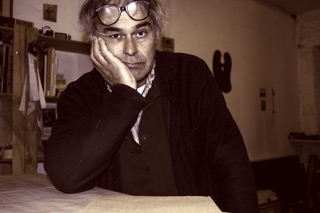Profile of an Artist
by Gabriel Solomons
(first published in Decode Magazine,
INTELLECT: Publishers of Original Thinking)
GS: Where do your images come from?
GB: I think they arise from an instinctive tendency to not look for semblances or analogies. Meaning, to find all that which tries to happen in spite of me; the inevitable association or metaphor of a form, rather than substituting one thing for another. Ultimately you come down to the question; does one proceed from an idea that issues from a form or from a representation of a form, as the majority perceives it. In other words, imagination versus verisimilitude.
One forever seems to be looking for a dimension not directly visible, and through the technique at one’s disposal express the sensation that evokes. As has been said; ‘The invisible doubles the visible.’Not everybody’s idea. There are lots of little old ladies who are perfectly happy to get a tree to look like what everybody thinks a tree should look like. But of course, nothing is what it seems. Each form is overlaid by memories we have, by temperament, by mood at that particular moment, which makes it impossible to express anything objectively.
GS: Do your childhood memories play an important part in your work?
GB: I grew up in Dordrecht, Holland, a city with a very rich tradition in painting, which of course influenced the way I saw and observed things. All my schooling and training was very traditional, very much rooted in the 19th century. But obviously the means traditionally handed down to you shouldn’t freeze you in the period in which they came about. They must allow & enable you to express your own period.
GS: How then would you describe memory?
GB: In ‘Artificial Paradises’ there is an essay of one page, the ‘Palimpsest’, in which Baudelaire describes the properties and processes of memory. Basically it notes that if we conceive of every experience as a transparent layer, and that each successive transparent layer is superimposed, these then would constitute a reading, which we add to and subtract from.
GS: What would you say is your philosophy that you live by as a painter?
GB: Philosophy is not of much use. One observes that all is uncertain at all times. Whirled about without a center this becomes that and that becomes this. Forms forever describing their own birth . . .
I think Czeslaw Milosz comes closest: “To see purely and simply, without name, without expectations, fears or hope at the edge, where there is no I or not I.


![CLICK TO ENLARGE. 'Tornado (Evil Wind, 16 9 2015)' [2017], Monotype and Casein tempera, 42x29cm (© by Gerard Bellaart)](http://www.artsjournal.com/herman/wp/wp-content/uploads/2017/09/Tornado-320.jpg)